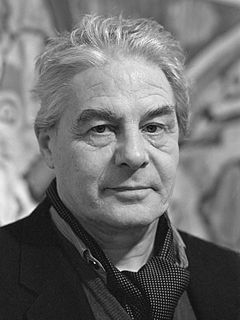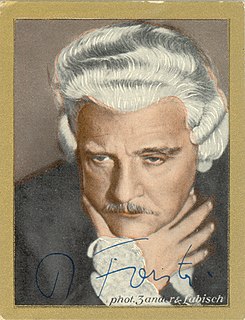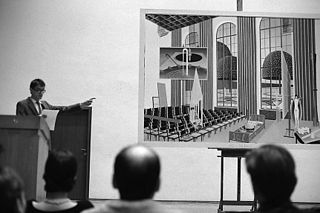Related Research Articles

Lucebert was a Dutch artist who first became known as the poet of the COBRA movement.

Charlotte Ander was a German actress.

Franz Gertsch is a Swiss painter known for his large format hyperrealistic portraits.

Georg John was a German stage and film actor.

Rudolf Forster was an Austrian film actor. He appeared in 106 films between 1914 and 1968. His autobiography Das Spiel, mein Leben was published by Propyläen Verlag in 1967. He was born in Gröbming, Austria, and died in Bad Aussee, Austria.

Franz Bronstert was a German engineer and painter.

It Is Not the Homosexual Who Is Perverse, But the Society in Which He Lives is a 1971 German camp film directed by Rosa von Praunheim. The plot follows the adventures of a young gay man from the province who arrives in Berlin. He gradually leaves behind his innocence led by his increasing appetite for excitement in the big-city gay scene. He moves from one gay milieu to another caught in his addiction for fashion and sexual experiences.

Carry Hauser, born Carl Maria Hauser, was an Austrian painter, stage set designer and poet.
Georg Philipp Wörlen was a German painter, particularly associated with Passau, Bavaria, Germany.

Anton Faistauer was an Austrian Expressionist painter.
Fritz Greiner (1879–1933) was an Austrian film actor.
Doris Schöttler-Boll was a German artist. She is known for her de-constructivist works that she initially described as a result of Photomontage and Collage.

Nanne Meyer, is a German artist. She is one of the first women artists of the postwar generation who works primarily in drawing. Meyer lives and works in Berlin.

Thomas Huber is a Swiss artist who lived and worked in Mettmann near Düsseldorf for several years and is currently resident in Berlin.
Sabine Funke is a German painter who lives and works since 1987 in Karlsruhe.

Joachim Schmettau is a German sculptor.
Ulrich Erben is a German painter. From 1980 to 2005, he was a Professor of Painting at the Kunstakademie Münster. He is known as a master of the color field style of abstract painting, closely related to abstract expressionism, in which he creates tension between a defined surface structure, his own method of applying paint to a canvas, and the relationship of various shades of white or color to each other in their placement as part of a composition on the flat plane of a canvas. In 1986 and 2008, he was awarded the Konrad-von-Soest Prize for Visual Arts by the Landschaftsverband Westfalen-Lippe.

Heinrich Ehmsen was a German painter and graphic artist.
Anna Plate was a German painter. She was a prolific creator of still lifes, watercolor flower paintings, street scenes and portraits.
References
- ↑ no exact date of foundation is known
- ↑ Seht Ihr die Dinge wie sie sind? Form ist Verkleidung, Augentrug. Die Dinge sind nicht,wie Ihr sie zu sehen glaubt! Drum werdet still und einfach, denn Ihr schaut aus Euren Augen und schaut nur die Oberfläche. Der Künstler kämpft Titanenkampf, den Dingen die Seele abzugewinnen, in ihre Tiefe zu dringen, die Oberfläche zu überwinden. So wird AUSDRUCK. - Und solches eint die Felsleute. As cited by Franz X. Hofer: Woran „Der Fels“ zerbrach, Essay in Der Fels, Künstlergemeinschaft 1921–1927 (see below)